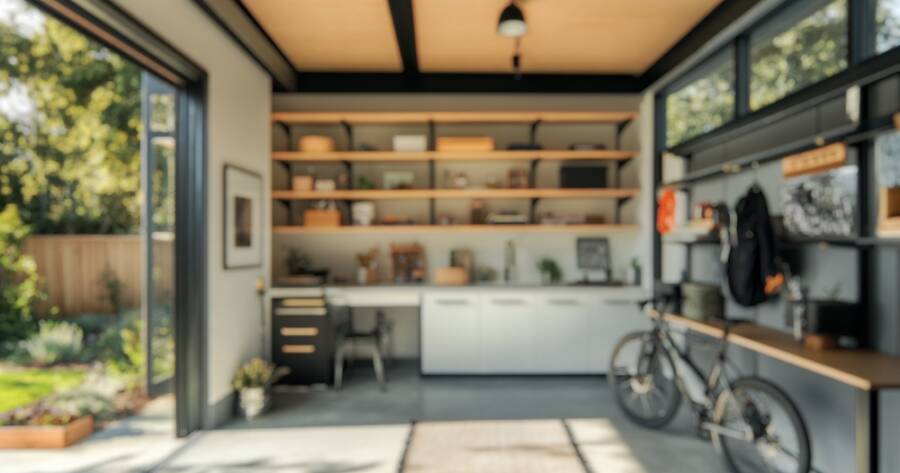A small yard doesn’t have to mean a cluttered one. With a bit of creativity and smart use of space, it’s possible to store tools, garden supplies, and outdoor gear without losing valuable room to relax. From vertical racks to compact sheds, modern storage solutions are designed to blend practicality with style. For homeowners across the United States, top storage solutions make it easier to keep outdoor spaces tidy, functional, and ready to enjoy year-round.
Step 1: Use Vertical Space Whenever Possible
When ground space is limited, the best approach is to think upward. Vertical storage makes use of walls, fences, or even freestanding panels to keep items organized. Wall-mounted racks for garden tools or folding chairs can instantly clear floor space, while tall shelving units hold planters, baskets, or small containers of soil and fertilizer.
If your yard has a sturdy fence, you can add hanging hooks or modular panels for hoses, rakes, and gloves. A vertical garden tower or stacked planter also adds a decorative touch while keeping essentials nearby. By turning walls into usable surfaces, you expand your storage without shrinking your usable yard area.
Step 2: Choose a Compact Shed or Storage Box
For larger items like lawnmowers, bicycles, or patio cushions, a small shed or deck box is ideal. Many compact sheds are designed to fit along the side of a house or garage and take up minimal depth. Look for options made from weather-resistant materials such as resin or coated steel, which can handle seasonal changes without rusting or warping.
A deck box doubles as both storage and seating—making it especially valuable in a small yard. These boxes can hold outdoor cushions, pool toys, or tools, and when closed, they serve as benches or coffee tables.
Examples of dual-purpose ideas include:
- Storage benches that blend with your patio furniture.
- Slimline sheds that fit under eaves or between structures.
Choosing pieces that perform more than one function is one of the most efficient ways to maximize a compact space.
Step 3: Keep It Weather-Proof and Pest-Proof
Outdoor storage only works if it protects what’s inside. Containers and sheds exposed to rain, wind, and sun need tight seals, strong lids, and durable hinges. Even in mild climates, moisture can cause mold or rust, while pests like insects and rodents may find their way into poorly sealed containers.
When buying a shed, check for features like raised floors, lockable doors, and built-in ventilation. Deck boxes should have overlapping lids that direct water away rather than letting it pool on top. If you’re building your own storage, use pressure-treated wood or recycled plastic lumber, both of which resist rot and weather damage.
It’s also smart to keep stored items off the ground by using pallets or shelves inside the structure. This keeps air circulating and extends the life of everything from cushions to garden tools.
Step 4: Make Hidden Storage Work for You
Small spaces benefit from furniture and structures that hide storage in plain sight. Consider a raised garden bed with a storage compartment underneath or a hollow bench along a fence line. If you have a deck or porch, you can install drawers or hinged panels beneath the flooring to keep seasonal items tucked away.
Planters, outdoor tables, and even privacy screens can be designed with built-in compartments. The goal is to make storage blend seamlessly with your yard’s design so it looks intentional rather than improvised. A cohesive look not only saves space but also adds to your outdoor area’s overall appeal.
Step 5: Stay Organized Year-Round
The best outdoor storage solutions won’t help much if they become overfilled or messy. Establish a simple system to keep things tidy—group similar items, label bins, and clean out the space at the start and end of each season.
Use smaller containers inside larger ones to keep accessories, gardening gloves, or repair kits from getting lost. Clear plastic boxes or color-coded totes make it easier to see what’s inside without unpacking everything. A little organization up front saves time and frustration later.
Step 6: Blend Form and Function
In a small yard, every square foot should look as good as it works. Choose colors and finishes that match your home’s exterior or garden theme. For example, natural wood tones blend nicely with greenery, while sleek gray or black resin boxes fit modern patios.
When everything feels coordinated—storage bins, furniture, and garden décor—the area looks intentional rather than cluttered. Even practical items like watering cans or hoses can become part of the design when neatly arranged or stored in attractive containers.
Small Space, Big Potential
Smart storage is the key to turning a small yard into a space that feels open and inviting. By using vertical surfaces, choosing multi-functional pieces, and keeping materials durable and weatherproof, you can maintain order without sacrificing beauty.
The right outdoor storage solutions make it possible to enjoy every inch of your yard—whether it’s for gardening, entertaining, or simply relaxing in a tidy, organized space that works hard for you all year long.

